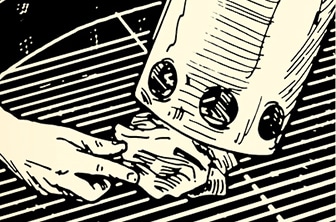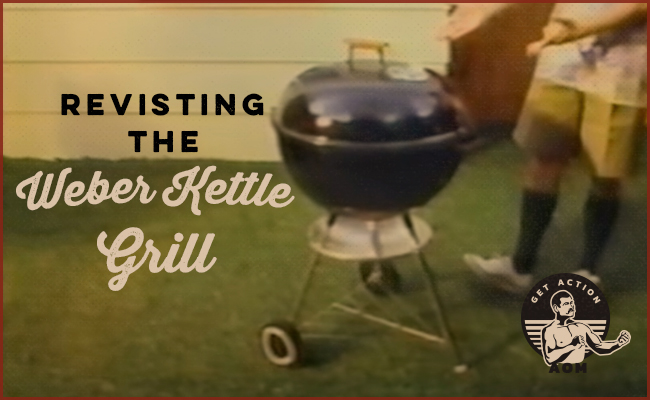
Note: This is NOT a sponsored article. We have no connection with Weber Grill. This is just a heartfelt article from a middle-aged dude waxing nostalgic about childhood summer cookouts where a Weber Kettle Grill took center stage.
It’s summertime, and that means cookouts.
When it comes to BBQ-ing around here, I’ve been using a gas grill during the 10 years I’ve lived in my house. It’s super convenient. Just turn the knob and light the grill. Bam. Fire.
Creating a three-zone fire on my gas grill is incredibly easy. A few twists of the knobs, and I can have a high-heat zone, medium-heat zone, and low-heat zone at the ready.
Yet, while I love the convenience of cooking with a gas grill, it does lack a certain charm that I associated with outdoor cooking growing up. Like a lot of American kids, my family had a charcoal-fueled Weber Kettle Grill in the backyard. With its black, porcelain-enameled lid and bowl, this iconic, spherical cooking device was a fixture of my suburban childhood. And getting that baby lit and going was like an ancestral ritual.
To my childhood mind, firing up a Weber charcoal grill had existential significance. It felt like an important, manly task because in my home, like I’m sure in many homes across America, my dad was in charge of it. It all started about an hour before eating time. First, Pops would wheel the grill out to the grass. Then he’d empty out the old ashes into a brown paper sack and hand me the cooking grate to go clean in the laundry room. When I got back, he’d pour a big pile of charcoal into the Weber’s shiny black bowl. Kingsford brand, natch. Then came a spray with some lighter fluid, and the strike and toss of a match.
WHOOSH!!!
After enjoying the sound of a newly birthed charcoal fire, we’d stand around the grill and watch the flame slowly get smaller and smaller, and the charcoal get whiter and whiter.
At a certain moment, Dad would decide that the charcoal was ready for cooking. On would go the grate, and an assortment of burger patties, hot dogs, and sausages were laid upon this culinary altar.
Once the victuals were hot and sizzling, they were eagerly placed inside soft Wonder Bread buns, slathered with ketchup and all the other fixins, and devoured with gusto. Each bite tasted of the charcoal-imparted flavor of smoke. Each bite tasted of summer. At least that’s how I remember it.
The other day as I was cooking burgers in a far more antiseptic fashion on my gas grill, I started waxing nostalgic about these Weber Grill-related memories of mine. I decided I wanted to try cooking on one myself, to see if it was as good as I recalled.
How to Use a Weber Kettle Grill

To get reacquainted with the Weber Kettle Grill as a grown man, I first went down to my local Home Depot and bought the classic model for myself. The grill set me back $120. Not bad for something that can provide years of use.
Then, I called my friend and resident AoM meat-cooking consultant, Karl Engel, and asked him to show me the ropes on how to cook with it. Here’s what he taught me.
Load Your Charcoal (You Don’t Need as Much as You Think)

Pick your charcoal of choice. You can’t go wrong with the standard Kingsford briquettes. Karl doesn’t like to use the Match Light variety, in which the briquettes are already coated in lighter fluid; he doesn’t think they burn as well, and he likes to control how much lighter fluid he puts on his charcoal, when he uses it (which is in cases where he doesn’t have a charcoal starter).
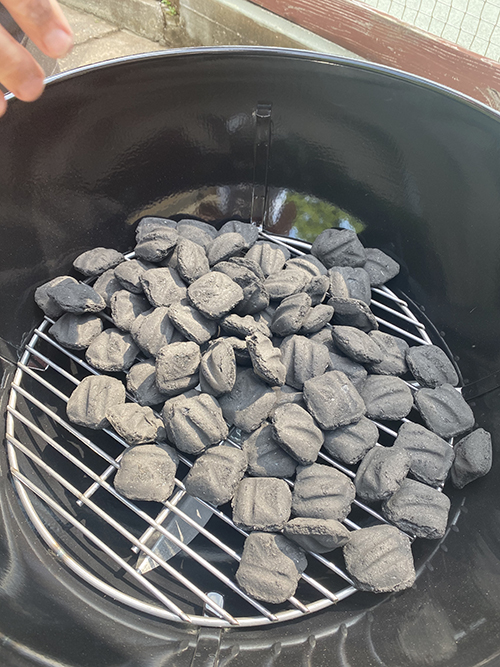
One thing Karl pointed out that dads in the 1970s and 80s got wrong about cooking with charcoal is that they used too much. As he told me: “My father would just pour half the bag into the kettle and create a ginormous pile. Every other dad I knew growing up did the same thing. I bet your dad did the same thing, too.”
He did indeed.
“You don’t need that much charcoal when you grill,” Karl went on to explain. “Less than you think you need. Maybe 1/4 of the bag.”
Note: Before you load new charcoal into the kettle, you’ll want to empty the ashes from the previous grilling session. It’s easy to do: just move the handle that opens and shuts the bottom vents back and forth and the ashes will fall into the the ash catcher below (the pie pan looking thing). Lift up the ash catcher and dump the ashes in a paper bag. Done.
Light Your Charcoal
Karl’s a fan of charcoal starters. Make sure to read our article on how to use them.
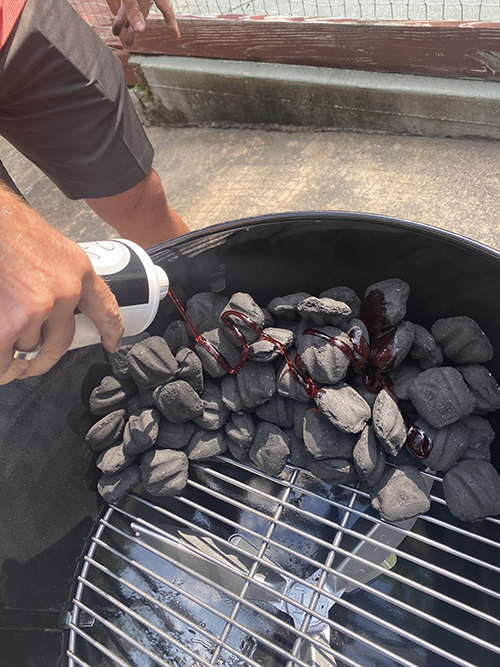
We didn’t have a charcoal starter on hand this time around, so we used some firestarter gel from Hasty-Bake. It’s great stuff. It doesn’t evaporate quickly like traditional lighter fluid and doesn’t give your meat that gross lighter fluid taste.

When he’s firing up his charcoal, Karl likes to shove all of it to one side of the kettle. It makes it easier to light. You can spread the briquettes out across the bottom once they’ve transformed into hot coals.
Make Sure Your Bottom Vents Are Open

The vents in the grill’s bowl and lid allow you to control the airflow into your grill. The more air, the hotter your fire will be. For grilling, you want a hot fire, so you want plenty of air to come in. Open those bottom vents up.
Wait Until the Charcoal Is Gray/White Before You Start Cooking

It takes about 30 minutes for the briquettes to turn gray/white, which signals that they’re ready to cook your food. While you’re waiting for the charcoal to reach that point, shoot the breeze or play cornhole.


Karl likes to spread the charcoal so that it covers about half of the kettle. Gives you a couple different heat zones.
Put on the Food, and the Lid — or Not

When grilling things like hot dogs and hamburgers, you don’t need to put the lid on.
“Grilling is all about high heat and using direct heat to cook each side of the meat, so you don’t need to use the lid. If I were grilling steaks, I might use the lid to get some oven-like cooking while I’m grilling the meat. In that case, I’d put the lid on and open up its vents,” Karl told me.
The Outcome
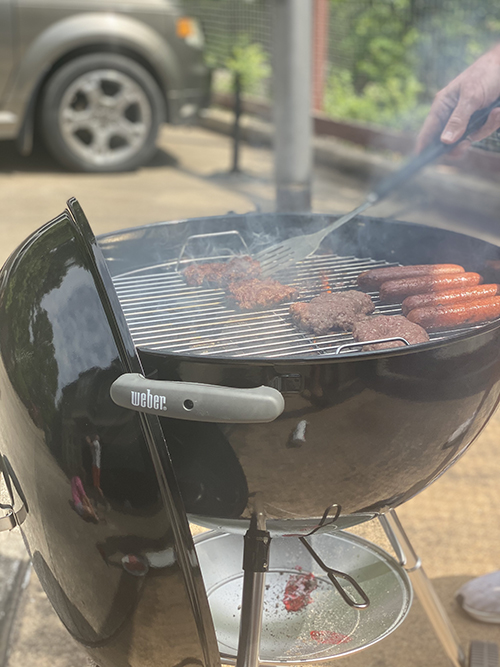
So did cooking with a Weber Kettle Grill in 2021 match up with my memories of what it was like in 1988?
One thing that I noticed while putting the grill together was that the materials just seemed chintzier and more flimsy than those on the Weber Kettle Grill my dad owned. (Weber grills are still assembled in America, but with some imported components.) The metal in the legs seems to bend pretty easily. The most significant difference that stood out to me was that all the handles on the new models have plastic instead of wood. The wood on the 1970s and 80s versions really classed things up. Oh well. That’s “progress” for ya.

Other than that, everything else was the same. The sound of the fire whooshing. The smell of smoldering charcoal and caramelizing meat.
I gotta say, charcoal definitely makes your burgers taste better than gas. Love that smokey flavor. Our kids rated their charcoal-cooked burgers an enthusiastic 10/10.
Cooking with a Weber Kettle Grill certainly takes more time and attention than using a gas grill. But as with all things in life, that effort transforms the task into more of an experience. I’ll continue to use my gas grill for weeknight dinners, but turn to the Weber when hosting things that I want to feel more like an event. In doing so, hopefully my kids will absorb the same Dad-imbued, charcoal-infused summertime impressions that waft through one’s memory for a lifetime.







